Daily News
by Gail Helmer
[ Send Us News | Archives ]
IL-2 Sturmovik Going Gold
Yes, it is true! The wait is finally over. COMBATSIM has learned that IL-2 Sturmovik will reach gold master this week and is expected to hit retail shelves by Mid-November. We will keep you posted on futher developments.
Lock On: Modern Air Combat Release Slips
COMBATSIM has received the latest news that SSI's, "Lock On: Modern Air Combat" (LOMAC), release date has slipped a month, from February to March 2002. LOMAC is SSI's follow-up to Flanker 2.x. What you always wished Flanker 2.x had, you'll see in LOMAC. It combines a broad scope of game play that includes a dynamic battle generator, an immersive combat environment, robust multi-player options, and in-your-face action.
New Screens: World War II- Panzer Claws
German publisher Zuxxez has released new work-in-progress screenshots of the real-time strategy game World War II: Panzer Claws from developer In Images. The title uses the all-new Earth III engine developed by Reality Pump Studios.

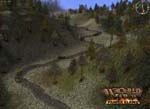
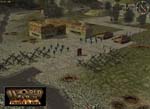
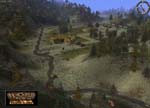
Set from 1941-1944, players participate in battles beginning with the attack of Germany on the USSR and continuing through decisive battles in the East, operations in France and Italy, and the German offensive in Ardennes Forest. The game offers three-dimensional terrain that changes in appearance depending on the time of the day as well as different weather and seasonal conditions. These changes also have an effect on unit behavior: At night their fighting value is lowered and their range of vision is diminished. In addition, unit speed is lower in the rain. An editor that will allow users to create their own maps and a complex multiplayer mode complete the picture for this game.
US Army Gets Into Games
Pandemic Studios has announced that the US Army has teamed up with University of Southern California, Sony Pictures ImageWorks, Pandemic Studios, and Quicksilver Software to develop two games that focus on modern military strategy. One game--C-Force--will be released for the latest console systems, and it will let players assume the role of a squad leader. The other game--CS-12--is being developed for the PC, and it will let players assume the role of a company commander.
The projects are a joint venture between the Institute for Creative Technologies (ICT), a group operated by the US Army and the University of Southern California; Future Combat Systems (FCS), a group operated by Sony Pictures ImageWorks and Pandemic Studios; and Quicksilver Software, the creator of Starfleet Command and developer of the upcoming Master of Orion III. Both C-Force and CS-12 will run in real time and will take advantage of ICT's research in artificial intelligence, graphics, and sound. For the first time, the US Army will not only provide funding, but it will also use its Training & Doctrine Command bureau to assist with the games' development. The games are being developed in part to help train future military commanders.
"Educators realize that most young people today play computer games, and that there must be a way to tap into this market for real learning," said ICT executive director Richard Lindheim. "While offering unique training aids for potential squad leaders or captains, these products will also teach game players everywhere about how to leverage human resources and information--skills that will benefit them enormously in their professional lives."
C-Force is in development at FCS, and CS-12 is in development at Quicksilver. Both games are planned for release within two years. For more information, visit the official Web sites of ICT, FCS, and Quicksilver Software.
Half-Life Heading To The Big Screen
Valve Software revealed that it has been approached by a number of filmmakers interested in creating a movie based on its groundbreaking first-person shooter, Half-Life. The developer is now soliciting feedback on the subject of a film, including what fans would like to see in the film, such as actors, storylines, and other suggestions, as well as whether fans would even be interested in seeing a movie based on the game.
Although the developer declined to name the filmmakers in question, it did confirm that the discussions involved at least a few major studios. Valve is soliciting feedback from its fans because it knows there are mixed opinions on the subject of games being made into movies. Valve is asking for comments on the subject to be sent to [email protected].
Military News
Lockheed Martin Wins JSF Contract For "F-35"
Competition for the Air Force's newest multirole aircraft ended Oct. 26 when Air Force Secretary Dr. James G. Roche announced the winner of the Defense Department's Joint Strike Fighter contract in a Pentagon press conference.
"Both proposals were very good, but on the basis of strengths, weaknesses and degrees of risk of the program, it is our conclusion that the Lockheed Martin team is the winner of the Joint Strike Fighter program on the best-value basis," said Roche.
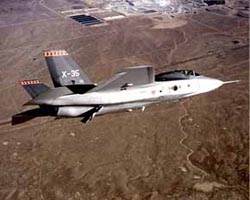
This selection will allow Lockheed Martin's X-35B to enter the next acquisition phase - system development and demonstration, said Edward C. "Pete" Aldridge Jr., undersecretary of defense for Acquisition, Technology and Logistics, in comments leading up to Roche's announcement.
"Today's Joint Strike Fighter announcement is a momentous step forward in our efforts to recapitalize and modernize the Air Force's aircraft fleet," said Gen. John P. Jumper, Air Force chief of staff, in a written statement. "(It) is an essential element of our continuing transformation.
"The JSF brings persistent stealth over the battlefield for the first time, and will enhance the lethality and survivability of American and allied combat air, sea and ground forces," Jumper said. "This dynamic multi-role aircraft brings a robust air-to-ground capability that will enable us to bring critical effects to bear on tomorrow's battlefield."
According to Aldridge, there will be three variants of the JSF: a conventional takeoff and landing variant for the Air Force; a carrier-deck compatible variant for the Navy; and a short takeoff and vertical landing variant for the Marine Corps and United Kingdom.
"The JSF will be the world's premiere strike platform beginning in 2008 and lasting through 2040," Aldridge said. "It will provide an air-to-air capability second only to the F-22 air superiority fighter. The JSF will allow for migration by U.S. forces to an almost all stealth fighter force by 2025."
The source selection process was very strict, he said.
It began when Boeing and Lockheed Martin were each awarded contracts to compete in the concept demonstration phase of the JSF program in 1996. They began flying their concept demonstrators, the X-32B and the X-35B respectively, in 2000.
This "fly-off" was designed to provide insights on basic aircraft performance, including commonality, modularity, short takeoff and vertical landing, hover and transition capabilities, and aircraft low-speed handling qualities.
The JSF is unique in that it is a joint program featuring a "family of aircraft" concept. It is designed to reduce development and production costs and the total cost of ownership by producing similar variants of the same aircraft for the each customer.
The Air Force will be the largest JSF customer, purchasing 1,763 of the conventional takeoff and landing version of the aircraft.
The Marine Corps is expected to purchase 609 of the short takeoff and vertical landing aircraft variant. The United Kingdom's Royal air force and navy are also expected to order 150 of the STOVL variant. The Navy is expected to buy about 480 of the carrier variant
Raytheon to Design and Produce US Army A2C2S
Raytheon Company recently received a $110 million contract covering the development, low rate initial production and the first year of full rate production for the U.S. Army's Airborne Command and Control System (A2C2S). The Army's Aviation and Missile Command in Huntsville, Ala., is the contracting agency.
A2C2S outfits selected Army UH-60L Blackhawk helicopters with a mission equipment package that transforms them into airborne command posts. The system enables commanders and their staffs-at brigade, division and above-to maintain digital command, control and communication while moving through the battlespace at 300 kilometers per hour. Called "C2 on-the-move," the new capability allows commanders to go wherever they are needed, yet maintain uninterrupted command and control (C2) within the spectrum of conflict. Raytheon's first task is to develop an A2C2S mission equipment package for the Blackhawk helicopter. During the contract's four-year, three-phase cycle, the company will deliver 34 systems.
"Raytheon is pleased to be helping the Army meet its transformation goals by developing and fielding this highly advanced, mobile C2 system," said Brian McKeon, Raytheon vice president of Command, Control and Battle Management Systems.
Lockheed Martin Team Gets Go Ahead
The long competition for the right to build the Joint Strike Fighter (JSF), the next generation airborne solution for the US and UK defence forces, has gone the way of Lockheed Martin and its partners Northrop Grumman and BAE SYSTEMS over a rival team headed by Boeing. A Pentagon announcement on Friday, revealed the team's X-35 to be the chosen design for the next stage of the JSF programme, designated System Development and Demonstration (SDD), in a contract worth $19 billion. All told the programme is valued at around $225 billion and the first F-35 should roll off the production line and into service in 2008.
The JSF programme is working toward a multi-functional aircraft, which will have three significant incarnations, a compatible variant for carrier landings (CV), a conventional take-off and landing (CTOL) variant, and a short take-off and vertical landing (STOVL) variant. The CV variant will fulfil the needs of the US Navy, the CTOL those of the US Air Force, and the STOVL will be utilised by the US Marines. The UK, the only collaborative partner on the programme, will examine the advantages of both the CV and STOVL designs before deciding which will replace the Sea Harrier.
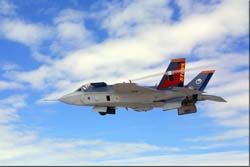
"We separately met with the companies so, and both proposals were very good; both demo programmes were very good. But on the basis of strengths, weaknesses and degrees of risk of the program, it is our conclusion, joined in by our colleagues from the United Kingdom, that the Lockheed Martin team is the winner of the Joint Strike Fighter programme on a best-value basis," said Secretary of the US Air Force Jim Roche on revealing the successful bid at Friday's briefing.
Much has been made throughout the programme of its winner-takes-all nature. Fears have been raised in Washington that because this programme should take fighter production up to 2040, and is solely in the hands of Lockheed Martin's team, that it could spell the end of competitive fighter production in the US. However, this theory was refuted by Under Secretary of Defence for Acquisitions, Technology and Logistics Edward C. "Pete" Aldridge Jr. at the news briefing.
"There are continuing production of fighter aircraft in the defence budget through the year 2012. The F-22 will continue in production with both Lockheed as a prime and Boeing as a subcontractor, building part of the airplane. And there's the continued production of the F-18 E and F. So, it was our view that this winner-take-all strategy was not going to interfere with a long-term competitive role for the fighter aircraft," he said.
Further backing the ideal of the winner-takes-all process the Under Secretary revealed that the Lockheed Martin team would be under no pressure to seek out assistance from Boeing as some politicians have advocated should be the case. "If Lockheed Martin wishes to use the unique talents of Boeing, they are free to do so. We're not forcing them to do it, but if they would like to do that, that's up to them," Aldridge said.
In a further, contractual announcement the Pentagon revealed that Pratt & Whitney have been engaged in a $4 billion process to develop the F135 propulsion system for the JSF. A second contract is soon to be signed for a separate team from General Electric and Rolls Royce. The two teams will develop, in competition, engines that can be interchangeable for all JSF variants.
These contracts represent a significant boon to the aerospace industry worldwide, which has been counting the cost since September 11th, albeit specifically on the commercial side of the market. Nowhere is this truer than in the UK. The British government is sinking £840 million into the SDD phase of the programme, which over its course is expected to realise approximately £28 billion for UK industry. Companies like BAE Systems and Rolls Royce will be celebrating Friday's developments, which are expected to create or safeguard 8,000 jobs in the long run. This is especially significant for Rolls Royce as the engine manufacturers recently let 5,000 workers go.
"The United Kingdom government, as a full partner in the collaborative Joint Strike Fighter program, is very happy to endorse the decision to move the JSF programme forward into the next phase and to pursue the Lockheed Martin contractual path," said Minister for Defence Procurement Lord Willy Bach.
The JSF represents the future of the manned fighter internationally. In addition to the UK's contribution, Denmark, Norway, the Netherlands, Canada, and Italy are on board as co-operative partners, with Singapore, Turkey and Israel as foreign military sales agents.
Spar Wins Canadian Hercules Aircraft GPS Contract
Spar Aerospace Limited has been awarded a Canadian Department of National Defence contract for the supply, installation and integration of a commercial off-the-shelf Global Positioning System in the Avionics Update Project (AUP) modified CC130 Hercules fleet of thirty-two aircraft.
The new GPS system to be installed is FAA approved which will allow navigation of commercial airways and GPS non-precision approaches.
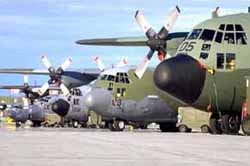
"Spar is very pleased to have worked closely with DND in defining this solution to enhance the CC130 navigation and flight management systems,'' said Harley Ranson, Vice President, Marketing Programmes.
The first aircraft installation begins immediately and the project is scheduled to be completed by December 2002.
Spar developed, installed and integrated the existing AUP suite of avionics systems into the DND CC130 fleet under a separate five-year Crown contract completed earlier this year.
The CC-130 Hercules aircraft is the workhorse of Canadian Forces' strategic and tactical airlift operations and is used in the Aerial Refueling, Search and Rescue roles, and to support international requirements as required.
U.S. Commando Solo II Takes Over Afghan Airwaves
After years of Taliban propaganda, the Afghan people are hearing another voice. At any time of the day or night, an Air Force Special Operations Command EC-130E Commando Solo II is in the area of operations and broadcasting news and information to the Afghan people.
The aircraft fly a variety of missions. In Afghanistan, they're broadcasting music, news and information in the various languages of the country. These are radio broadcasts only.
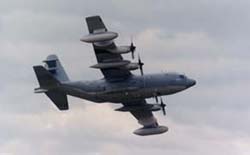
The planes are part of the 193rd Special Operations Wing of the Pennsylvania Air National Guard. They are based at Harrisburg International Airport, Pa.
Army specialists in the language and customs of the area prepare the broadcasts.
The capability allows U.S. Central Command planners to warn the Afghan population to stay away from Taliban and Al Qaeda targets. The broadcasts stress that the coalition campaign is not aimed at the Afghan people, but at the terrorists and their Taliban supporters.
"We have no wish to hurt you, the innocent people of Afghanistan," reads one English translation of a broadcast. "Stay away from military installations, government buildings, terrorist camps, roads, factories or bridges."
Another broadcast told the people of Afghanistan why the United States is attacking the Taliban and Al Qaeda. "On Sept. 11, 2001, thousands of people were killed en masse in the United States," it reads. "Among them was a two-year- old girl. Barely able to stand or dress herself. Did she deserve to die? Why was she killed you ask? Was she a thief? What crime had she committed? She was merely on a trip with her family to visit her grandparents. Policemen, firefighters, teachers, doctors, mothers, father, sisters, brothers all killed. Why?"
The broadcast went on to explain that the attacks in New York and the Pentagon were on innocent people -- an act forbidden by the Muslim Koran. "(The terrorists) believe they are heroes, Ghazi warriors triumphing over the evil of the West," the broadcast continues. "However, the truth is they are murderers and do not represent Islam." Ghazi warriors are Muslim heroes from the early days of the religion.
Ham radio operators can listen to the broadcast at 8700 kilohertz, said Air Force 1st Lt. Edward Shank, a spokesman for the squadron. The squadron has participated in operations in Panama, Bosnia, Kosovo and during the Gulf War. Their aircraft have been modified to not only handle radio, but television broadcasts. They can broadcast via tape or live. "If needed, we have the capability to take a speech by the President of the United States and beam it live via satellite to the aircraft, which then would broadcast it," Shank said.
The name "Commando Solo II" also has meaning. Commando refers to the special operations mission, and Solo refers to the fact that the aircraft can go it alone, Shank said.
[ Send Us News | Archives ]
by Gail Helmer
Monday October 29, 2001
- IL-2 Sturmovik Going Gold
- Lock On: Modern Air Combat Release Slips
- New Screens: World War II- Panzer Claws
- US Army Gets Into Games
- Half-Life Heading To The Big Screen
- Lockheed Martin Wins JSF Contract For "F-35"
- Raytheon to Design and Produce US Army A2C2S
- Lockheed Martin Team Gets Go Ahead
- Spar Wins Canadian Hercules Aircraft GPS Contract
- U.S. Commando Solo II Takes Over Afghan Airwaves
IL-2 Sturmovik Going Gold
Yes, it is true! The wait is finally over. COMBATSIM has learned that IL-2 Sturmovik will reach gold master this week and is expected to hit retail shelves by Mid-November. We will keep you posted on futher developments.
Lock On: Modern Air Combat Release Slips
COMBATSIM has received the latest news that SSI's, "Lock On: Modern Air Combat" (LOMAC), release date has slipped a month, from February to March 2002. LOMAC is SSI's follow-up to Flanker 2.x. What you always wished Flanker 2.x had, you'll see in LOMAC. It combines a broad scope of game play that includes a dynamic battle generator, an immersive combat environment, robust multi-player options, and in-your-face action.
New Screens: World War II- Panzer Claws
German publisher Zuxxez has released new work-in-progress screenshots of the real-time strategy game World War II: Panzer Claws from developer In Images. The title uses the all-new Earth III engine developed by Reality Pump Studios.




Set from 1941-1944, players participate in battles beginning with the attack of Germany on the USSR and continuing through decisive battles in the East, operations in France and Italy, and the German offensive in Ardennes Forest. The game offers three-dimensional terrain that changes in appearance depending on the time of the day as well as different weather and seasonal conditions. These changes also have an effect on unit behavior: At night their fighting value is lowered and their range of vision is diminished. In addition, unit speed is lower in the rain. An editor that will allow users to create their own maps and a complex multiplayer mode complete the picture for this game.
US Army Gets Into Games
Pandemic Studios has announced that the US Army has teamed up with University of Southern California, Sony Pictures ImageWorks, Pandemic Studios, and Quicksilver Software to develop two games that focus on modern military strategy. One game--C-Force--will be released for the latest console systems, and it will let players assume the role of a squad leader. The other game--CS-12--is being developed for the PC, and it will let players assume the role of a company commander.
The projects are a joint venture between the Institute for Creative Technologies (ICT), a group operated by the US Army and the University of Southern California; Future Combat Systems (FCS), a group operated by Sony Pictures ImageWorks and Pandemic Studios; and Quicksilver Software, the creator of Starfleet Command and developer of the upcoming Master of Orion III. Both C-Force and CS-12 will run in real time and will take advantage of ICT's research in artificial intelligence, graphics, and sound. For the first time, the US Army will not only provide funding, but it will also use its Training & Doctrine Command bureau to assist with the games' development. The games are being developed in part to help train future military commanders.
"Educators realize that most young people today play computer games, and that there must be a way to tap into this market for real learning," said ICT executive director Richard Lindheim. "While offering unique training aids for potential squad leaders or captains, these products will also teach game players everywhere about how to leverage human resources and information--skills that will benefit them enormously in their professional lives."
C-Force is in development at FCS, and CS-12 is in development at Quicksilver. Both games are planned for release within two years. For more information, visit the official Web sites of ICT, FCS, and Quicksilver Software.
Half-Life Heading To The Big Screen
Valve Software revealed that it has been approached by a number of filmmakers interested in creating a movie based on its groundbreaking first-person shooter, Half-Life. The developer is now soliciting feedback on the subject of a film, including what fans would like to see in the film, such as actors, storylines, and other suggestions, as well as whether fans would even be interested in seeing a movie based on the game.
Although the developer declined to name the filmmakers in question, it did confirm that the discussions involved at least a few major studios. Valve is soliciting feedback from its fans because it knows there are mixed opinions on the subject of games being made into movies. Valve is asking for comments on the subject to be sent to [email protected].
Military News
Lockheed Martin Wins JSF Contract For "F-35"
Competition for the Air Force's newest multirole aircraft ended Oct. 26 when Air Force Secretary Dr. James G. Roche announced the winner of the Defense Department's Joint Strike Fighter contract in a Pentagon press conference.
"Both proposals were very good, but on the basis of strengths, weaknesses and degrees of risk of the program, it is our conclusion that the Lockheed Martin team is the winner of the Joint Strike Fighter program on the best-value basis," said Roche.

This selection will allow Lockheed Martin's X-35B to enter the next acquisition phase - system development and demonstration, said Edward C. "Pete" Aldridge Jr., undersecretary of defense for Acquisition, Technology and Logistics, in comments leading up to Roche's announcement.
"Today's Joint Strike Fighter announcement is a momentous step forward in our efforts to recapitalize and modernize the Air Force's aircraft fleet," said Gen. John P. Jumper, Air Force chief of staff, in a written statement. "(It) is an essential element of our continuing transformation.
"The JSF brings persistent stealth over the battlefield for the first time, and will enhance the lethality and survivability of American and allied combat air, sea and ground forces," Jumper said. "This dynamic multi-role aircraft brings a robust air-to-ground capability that will enable us to bring critical effects to bear on tomorrow's battlefield."
According to Aldridge, there will be three variants of the JSF: a conventional takeoff and landing variant for the Air Force; a carrier-deck compatible variant for the Navy; and a short takeoff and vertical landing variant for the Marine Corps and United Kingdom.
"The JSF will be the world's premiere strike platform beginning in 2008 and lasting through 2040," Aldridge said. "It will provide an air-to-air capability second only to the F-22 air superiority fighter. The JSF will allow for migration by U.S. forces to an almost all stealth fighter force by 2025."
The source selection process was very strict, he said.
It began when Boeing and Lockheed Martin were each awarded contracts to compete in the concept demonstration phase of the JSF program in 1996. They began flying their concept demonstrators, the X-32B and the X-35B respectively, in 2000.
This "fly-off" was designed to provide insights on basic aircraft performance, including commonality, modularity, short takeoff and vertical landing, hover and transition capabilities, and aircraft low-speed handling qualities.
The JSF is unique in that it is a joint program featuring a "family of aircraft" concept. It is designed to reduce development and production costs and the total cost of ownership by producing similar variants of the same aircraft for the each customer.
The Air Force will be the largest JSF customer, purchasing 1,763 of the conventional takeoff and landing version of the aircraft.
The Marine Corps is expected to purchase 609 of the short takeoff and vertical landing aircraft variant. The United Kingdom's Royal air force and navy are also expected to order 150 of the STOVL variant. The Navy is expected to buy about 480 of the carrier variant
Raytheon to Design and Produce US Army A2C2S
Raytheon Company recently received a $110 million contract covering the development, low rate initial production and the first year of full rate production for the U.S. Army's Airborne Command and Control System (A2C2S). The Army's Aviation and Missile Command in Huntsville, Ala., is the contracting agency.
A2C2S outfits selected Army UH-60L Blackhawk helicopters with a mission equipment package that transforms them into airborne command posts. The system enables commanders and their staffs-at brigade, division and above-to maintain digital command, control and communication while moving through the battlespace at 300 kilometers per hour. Called "C2 on-the-move," the new capability allows commanders to go wherever they are needed, yet maintain uninterrupted command and control (C2) within the spectrum of conflict. Raytheon's first task is to develop an A2C2S mission equipment package for the Blackhawk helicopter. During the contract's four-year, three-phase cycle, the company will deliver 34 systems.
"Raytheon is pleased to be helping the Army meet its transformation goals by developing and fielding this highly advanced, mobile C2 system," said Brian McKeon, Raytheon vice president of Command, Control and Battle Management Systems.
Lockheed Martin Team Gets Go Ahead
The long competition for the right to build the Joint Strike Fighter (JSF), the next generation airborne solution for the US and UK defence forces, has gone the way of Lockheed Martin and its partners Northrop Grumman and BAE SYSTEMS over a rival team headed by Boeing. A Pentagon announcement on Friday, revealed the team's X-35 to be the chosen design for the next stage of the JSF programme, designated System Development and Demonstration (SDD), in a contract worth $19 billion. All told the programme is valued at around $225 billion and the first F-35 should roll off the production line and into service in 2008.
The JSF programme is working toward a multi-functional aircraft, which will have three significant incarnations, a compatible variant for carrier landings (CV), a conventional take-off and landing (CTOL) variant, and a short take-off and vertical landing (STOVL) variant. The CV variant will fulfil the needs of the US Navy, the CTOL those of the US Air Force, and the STOVL will be utilised by the US Marines. The UK, the only collaborative partner on the programme, will examine the advantages of both the CV and STOVL designs before deciding which will replace the Sea Harrier.

"We separately met with the companies so, and both proposals were very good; both demo programmes were very good. But on the basis of strengths, weaknesses and degrees of risk of the program, it is our conclusion, joined in by our colleagues from the United Kingdom, that the Lockheed Martin team is the winner of the Joint Strike Fighter programme on a best-value basis," said Secretary of the US Air Force Jim Roche on revealing the successful bid at Friday's briefing.
Much has been made throughout the programme of its winner-takes-all nature. Fears have been raised in Washington that because this programme should take fighter production up to 2040, and is solely in the hands of Lockheed Martin's team, that it could spell the end of competitive fighter production in the US. However, this theory was refuted by Under Secretary of Defence for Acquisitions, Technology and Logistics Edward C. "Pete" Aldridge Jr. at the news briefing.
"There are continuing production of fighter aircraft in the defence budget through the year 2012. The F-22 will continue in production with both Lockheed as a prime and Boeing as a subcontractor, building part of the airplane. And there's the continued production of the F-18 E and F. So, it was our view that this winner-take-all strategy was not going to interfere with a long-term competitive role for the fighter aircraft," he said.
Further backing the ideal of the winner-takes-all process the Under Secretary revealed that the Lockheed Martin team would be under no pressure to seek out assistance from Boeing as some politicians have advocated should be the case. "If Lockheed Martin wishes to use the unique talents of Boeing, they are free to do so. We're not forcing them to do it, but if they would like to do that, that's up to them," Aldridge said.
In a further, contractual announcement the Pentagon revealed that Pratt & Whitney have been engaged in a $4 billion process to develop the F135 propulsion system for the JSF. A second contract is soon to be signed for a separate team from General Electric and Rolls Royce. The two teams will develop, in competition, engines that can be interchangeable for all JSF variants.
These contracts represent a significant boon to the aerospace industry worldwide, which has been counting the cost since September 11th, albeit specifically on the commercial side of the market. Nowhere is this truer than in the UK. The British government is sinking £840 million into the SDD phase of the programme, which over its course is expected to realise approximately £28 billion for UK industry. Companies like BAE Systems and Rolls Royce will be celebrating Friday's developments, which are expected to create or safeguard 8,000 jobs in the long run. This is especially significant for Rolls Royce as the engine manufacturers recently let 5,000 workers go.
"The United Kingdom government, as a full partner in the collaborative Joint Strike Fighter program, is very happy to endorse the decision to move the JSF programme forward into the next phase and to pursue the Lockheed Martin contractual path," said Minister for Defence Procurement Lord Willy Bach.
The JSF represents the future of the manned fighter internationally. In addition to the UK's contribution, Denmark, Norway, the Netherlands, Canada, and Italy are on board as co-operative partners, with Singapore, Turkey and Israel as foreign military sales agents.
Spar Wins Canadian Hercules Aircraft GPS Contract
Spar Aerospace Limited has been awarded a Canadian Department of National Defence contract for the supply, installation and integration of a commercial off-the-shelf Global Positioning System in the Avionics Update Project (AUP) modified CC130 Hercules fleet of thirty-two aircraft.
The new GPS system to be installed is FAA approved which will allow navigation of commercial airways and GPS non-precision approaches.

"Spar is very pleased to have worked closely with DND in defining this solution to enhance the CC130 navigation and flight management systems,'' said Harley Ranson, Vice President, Marketing Programmes.
The first aircraft installation begins immediately and the project is scheduled to be completed by December 2002.
Spar developed, installed and integrated the existing AUP suite of avionics systems into the DND CC130 fleet under a separate five-year Crown contract completed earlier this year.
The CC-130 Hercules aircraft is the workhorse of Canadian Forces' strategic and tactical airlift operations and is used in the Aerial Refueling, Search and Rescue roles, and to support international requirements as required.
U.S. Commando Solo II Takes Over Afghan Airwaves
After years of Taliban propaganda, the Afghan people are hearing another voice. At any time of the day or night, an Air Force Special Operations Command EC-130E Commando Solo II is in the area of operations and broadcasting news and information to the Afghan people.
The aircraft fly a variety of missions. In Afghanistan, they're broadcasting music, news and information in the various languages of the country. These are radio broadcasts only.

The planes are part of the 193rd Special Operations Wing of the Pennsylvania Air National Guard. They are based at Harrisburg International Airport, Pa.
Army specialists in the language and customs of the area prepare the broadcasts.
The capability allows U.S. Central Command planners to warn the Afghan population to stay away from Taliban and Al Qaeda targets. The broadcasts stress that the coalition campaign is not aimed at the Afghan people, but at the terrorists and their Taliban supporters.
"We have no wish to hurt you, the innocent people of Afghanistan," reads one English translation of a broadcast. "Stay away from military installations, government buildings, terrorist camps, roads, factories or bridges."
Another broadcast told the people of Afghanistan why the United States is attacking the Taliban and Al Qaeda. "On Sept. 11, 2001, thousands of people were killed en masse in the United States," it reads. "Among them was a two-year- old girl. Barely able to stand or dress herself. Did she deserve to die? Why was she killed you ask? Was she a thief? What crime had she committed? She was merely on a trip with her family to visit her grandparents. Policemen, firefighters, teachers, doctors, mothers, father, sisters, brothers all killed. Why?"
The broadcast went on to explain that the attacks in New York and the Pentagon were on innocent people -- an act forbidden by the Muslim Koran. "(The terrorists) believe they are heroes, Ghazi warriors triumphing over the evil of the West," the broadcast continues. "However, the truth is they are murderers and do not represent Islam." Ghazi warriors are Muslim heroes from the early days of the religion.
Ham radio operators can listen to the broadcast at 8700 kilohertz, said Air Force 1st Lt. Edward Shank, a spokesman for the squadron. The squadron has participated in operations in Panama, Bosnia, Kosovo and during the Gulf War. Their aircraft have been modified to not only handle radio, but television broadcasts. They can broadcast via tape or live. "If needed, we have the capability to take a speech by the President of the United States and beam it live via satellite to the aircraft, which then would broadcast it," Shank said.
The name "Commando Solo II" also has meaning. Commando refers to the special operations mission, and Solo refers to the fact that the aircraft can go it alone, Shank said.
